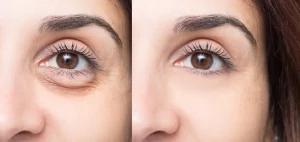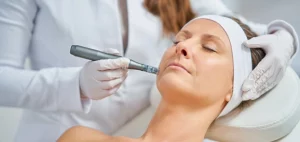Platelet-Rich Plasma (PRP) therapy has emerged as a viable non-surgical treatment option for everyone who wants to prevent hair loss and increase hair growth. PRP injections stimulate hair follicles, increasing hair renewal and enhancing hair thickness by utilizing the body’s natural healing capabilities present in platelets.
If you are thinking of opting PRP for hair loss, you might wonder how long it would take for PRP treatment to show its visible results.
In this blog by Syra Aesthetics, we will answer and explain the most common queries – How Long It Takes for PRP to Work on Hair, how PRP injections work for hair loss, the time it takes for PRP to impact hair, and the longevity of PRP’s outcomes.
How Do PRP Injections Work for Hair Loss?
PRP injections leverage the regenerative capabilities of platelets to stimulate hair growth. The process for PRP treatment involves the following steps listed below:
1. Blood Extraction: A small amount of the patient’s blood is drawn, typically from the arm.
Extracting the patient’s blood is the first step in the PRP treatment process. A medical practitioner will clean the area from where the blood is to be removed, which is usually the arm. Then a sterile needle is used to collect a small quantity of blood into a specialized tube.
To avoid any contamination, aseptic techniques are required to be followed during blood extraction. The blood sample is obtained while ensuring that it does not cause any discomfort or pain to the patient. The blood is then transported to the laboratory for additional processing.
2. Centrifugation: The drawn blood is spun in a centrifuge to separate the platelet-rich plasma from all the other components present in the blood.
The stored blood sample is then placed in a centrifuge machine as the following step in the PRP procedure. A centrifuge is a medical device that rapidly spins the blood at high velocities, causing its constituents to segregate based on density. This spinning process effectively separates the denser red blood cells from the plasma, which encompasses platelets and other crucial components.
Centrifugation typically takes several minutes, during which the blood stratifies into three distinct layers. The layer containing platelet-rich plasma (PRP) is then meticulously isolated from the remaining constituents. This PRP layer comprises a concentrated quantity of platelets and growth factors.
3. Platelet Activation: The extracted PRP is then activated, causing growth factors to be released, and boosting its therapeutic potential.
The collected platelet-rich plasma is then activated to release the full potential of PRP, which is accomplished by adding a small amount of activator to the PRP, such as calcium chloride or thrombin. Activation causes platelets to produce growth factors and other bioactive proteins, enhancing their ability to stimulate tissue repair and rejuvenation.
The growth factors generated by activated PRP are critical in improving hair follicle health and boosting hair growth. These growth factors promote cell proliferation, tissue regeneration, and blood vessel creation – contributing to healthier and stronger hair growth.
4. Injection: The activated PRP is painstakingly injected into the scalp, specifically targeting areas of thinning hair and lost hair.
PRP is ready for injection once it has been prepared and activated. The scalp is cleaned adequately before the injection; if necessary, a local anesthetic is used to reduce discomfort during the process.
The activated PRP is injected directly into the areas of the scalp with thin or lost hair using a tiny needle. The injections are applied selectively to target the hair follicles and accelerate their development. A medical expert with experience in PRP treatment usually carries out the procedure.
How Long Does It Take for PRP to Work on Hair?
Based on individual circumstances and the extent of hair loss, the timeline for PRP hair results can vary from person to person. While some individuals may experience faster outcomes, most patients notice improvements 3 to 6 months after the initial therapy. Individual responses to the hair regrowth process may differ.
Initial Phase (first 3 months):
There may be no noticeable changes in hair growth during the first couple of months after PRP treatment – However, some people do notice a decrease in hair shedding during this Phase.
Growth Phase (3 to 6 months):
Many patients witness enhanced hair texture and thickness around the 3rd-month mark. Hair growth becomes more noticeable, and the hair looks may begin to improve.
Mature Stage (6 months and up):
The majority of people get more noticeable improvements after the sixth month. Hair regeneration becomes more apparent, and new hair may be more assertive and healthier.
Individual reactions to PRP treatment might vary; some patients may have more rapid or slower improvements.
How Long Does PRP Last for Hair?
The duration of PRP’s effectiveness for hair varies for each individual. Most patients schedule follow-up sessions after the initial treatment to retain the advantages of PRP. These sessions are usually planned every 6 to 12 months, depending on individual needs and hair regeneration development.
The patient’s age, overall health, the severity of hair loss, and the number of PRP sessions obtained can all impact the treatment’s lifespan.
Conclusion
Platelet-rich plasma (PRP) hair loss treatment is a non-surgical and natural method of encouraging hair regrowth and enhancing hair density. While individual results may vary, most patients should expect noticeable improvements within 3 to 6 months of the initial PRP treatment. Follow-up treatments are required regularly to preserve the benefits of PRP and stimulate continuous hair growth.
If you’re thinking about getting PRP for hair loss, you should first consult our certified aestheticians at Syra Aesthetics to see if you’re a candidate for the process and to build a personalized treatment plan. PRP can be a helpful tool in revitalizing your hair and boosting your self-confidence with patience, good care, and regular maintenance.

About The Author
Dr. Syra Hanif M.D.
Board Certified Primary Care Physician
Dr. Hanif is the Director of Aesthetic Medicine. She is a board-certified physician in Aesthetic Medicine who specializes in using non-surgical alternatives in order to enhance one's appearance through Botox and fillers.
Read More











